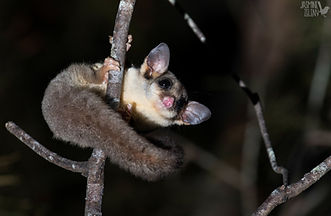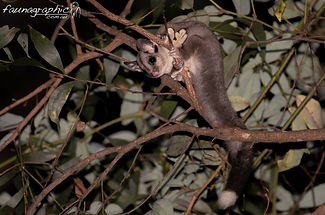The habitat of these animals would be threatened by the tree clearing, construction, noise and lights on Mt Coot-tha for the proposed adventure tourism megazipline development. Brisbane City Council is buying up bushland for wildlife corridors at a cost of $30m/ year to ratepayers and turning the land into conservation reserves that are generally accessible to the public. Brisbane Times 20.3.18 Ruth McCosker Council Buys the Equivalent of 400 Suncorp Statiums; The Courier Mail 6.12.16 Tom Snowdon Buying up Bushland for Wildlife Corridor
So why are they partially funding (at least $1.8 m) a megazipline construction by a private developer on Mt Coot-tha and risking the removal of animal habitat and wildlife corridors?
Sugar Gliders
This wildlife post is about the Sugar Glider (Petaurus breviceps) 26 July 2018
The Sugar Glider is a small, nocturnal, gliding mammal with brown/grey fur and a dark dorsal stripe which extends from between the eyes, across the top of the head and down the body. They are around 170mm (body length) with a tail longer than their body at 190mm.
Of course, being gliders, they are equipped with a gliding membrane which extends from the wrists to the ankles. This gliding membrane allows them to glide up to 50m between trees.
Sugar Gliders feed on flowers, nectar, pollen, and tree sap, as well as invertebrates.
They are a social animal and can form groups of as many as 10 individuals known as a clan, they will happily snuggle up and share a nest in a tree hollow lined with leaves. Although they are social, they will defend their territories against different groups. Dominant males of different clans use their scent glands to mark their territory.
Sugar Gliders give birth to 1-2 young, they develop in the pouch and leave the pouch around 2 months where they may ride on the mothers back as they begin to gain their independence. They are fully independent at 7-10 months, at this age young females may stay in the clan but young males are forced to disperse and find their own territories.
Sugar Gliders have a variety of vocalisations but the most commonly heard is the “yip yip yip” call which sounds like a tiny dog. You can hear this often at night if you’re in the right areas.
Squirrel Gliders are much more widespread throughout Brisbane than Sugar Gliders are, and the two species can easily be mixed up. There are a few easy features to look for when it comes to separating the two. The Sugar Glider has a “roman nose” and a blunt face whereas the Squirrel Glider has a much longer, pointier nose.
Squirrel Gliders have a very fluffy tail, especially at the base, while Sugar Gliders have much thinner tails which can sometimes have a white tip (roughly 25% of them), but not always. It is important to remember that the white tail tip is not a reliable feature as it won’t always be present, too many people rely on this.
My first image shows the features of a Sugar Glider really well, the blunt face, the thin tail (especially at the base) and while this individual does have a white tail tip, as I mentioned, this is not consistent.
I am yet to get a Squirrel Glider in the same position as the Sugar Glider in the first image but my last image is a Squirrel Glider (the rest are all Sugars). Sugar Gliders are of course threatened by loss of habitat which provide hollow bearing trees and food trees, as well as fire, and introduced predators such as cats and foxes. I have seen these guys all over Mt Coot-tha (including in the talons of a Powerful Owl :O) as well in bushland around Anstead, Brookfield, Kenmore Hills.


Jasmine Zelený is a wildlife scientist who is passionate about educating people and fighting for the preservation of these amazing animals. She regularly posts on the facebook site 4069 Community & Surrounds focusing on different species for her articles. All photos by Jasmine









